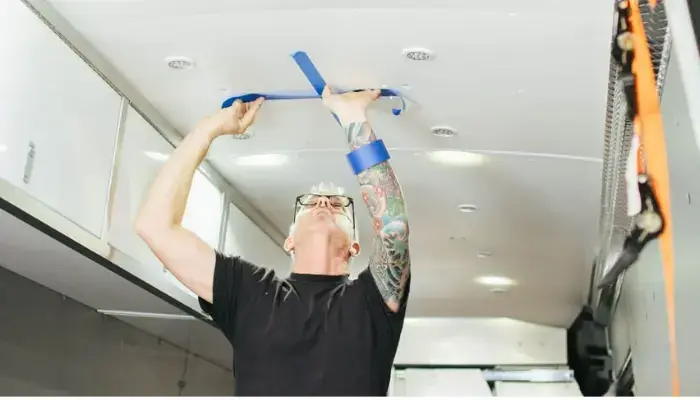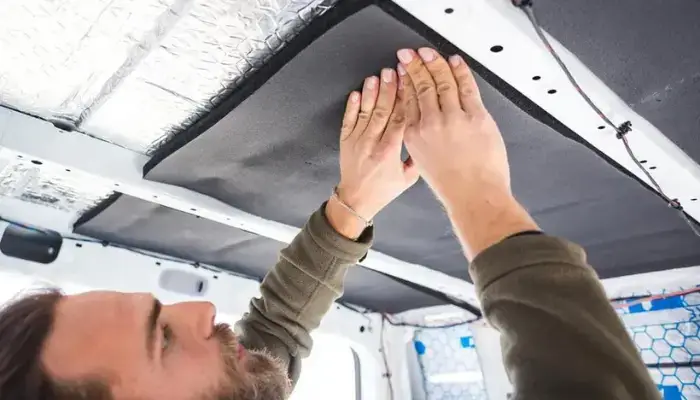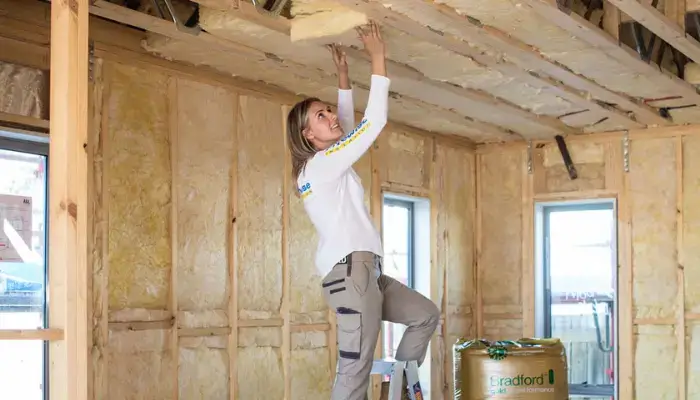Are you troubled by the noise coming from your neighbor or upstairs neighbor’s house and you want to get rid of it because neither you are getting sleep nor you are able to work then read this article of ours Read How to soundproof a ceiling? that will help you
The year 2023 is notable for the increased interest many individuals are showing in soundproofing their apartment ceilings. It almost seems as though putting yourself through a workout regimen in front of your above neighbor and then watching television nonstop all day is wearing on your nerves.
Fortunately, soundproofing your ceiling isn’t as difficult as it may appear. This might even be a DIY project, depending on the sort of ceiling in your room and the kind of sound leaking you’re experiencing.
No matter if the neighbor is creating noise or not, soundproofing the ceiling from the neighbor who lives above your unit is crucial if you live in an apartment.
There are two types of noise: airborne noise and impact noise. Airborne noise can be reduced by utilizing soundproof materials, but impact noise is far more challenging to reduce.
Impact noise, also known as structure-generated noise, is typically brought on by the steps or feet of an object on the ceiling. It is generally defined as the sound produced by the impact or collision of two things. or to drop.
If the person who lives above your apartment is mature enough, he might realize before you urge him to stop shouting or moving more quickly.
Therefore, you must fix or separate your ceiling from the middle-layer main ceiling of both flats, and you can do this by installing a soundproof ceiling.
Ceilings can be soundproofed using drywall, flexible channel, insulation, or by adding a new layer on top of an existing one. Which of these methods is, however, the most efficient?
However, if you’re having trouble with the floor and need advice on how to soundproof an existing floor, see our recommended tutorial.
In order to eliminate or significantly minimize impact noise coming from the above apartment, we’ll learn how to soundproof an existing ceiling in this article.
I’ve decided to share 5 excellent methods with you, and you may either try them all at once or pick the one you like most.
list of the 11 best ways how to soundproof a ceiling
1. Determine what you are hearing first
Identifying the sounds you hear can help you understand what you have to work with before you start this assignment.
Impact noise and airborne noise are the two types of noise that ceiling soundproofing is intended to reduce.
Drew describes impact noise as a sound that goes through the building itself and reverberates its way down to you. It sounds like footsteps or a chair dragging across the floor in the flat above you.
Voices or music would be examples of airborne noise, and it moves in waves through the building’s open spaces.
Finally, soundproofing your ceiling won’t do anything to reduce flanking noise, which often originates from the outside environment.
Drew said that while soundproofing your ceiling would lessen impact noises from above, it is better for airborne noise, therefore he suggests it for people who are expressly looking for “greater privacy and a quieter environment.”
2. check out your ceiling.

You must determine the type of your ceilings if you are convinced that the noise you are hearing is airborne or impact noise. The two varieties are suspended ceilings, often known as drop ceilings, and conventional drywall, an open space of smooth material. Tiles with frames make up suspended ceilings, which are typically constructed to conceal plumbing or ducting.
Drop ceilings can be more difficult to soundproof than drywall ceilings since they already have more room for sounds to reverberate, but they are not impossible.
3. Fix The Ceiling’s Holes Or Gaps.

When you check the roof thoroughly and you find some holes in the roof then you have to consider filling them. You can do this work on your own too, just you should know how to use the right material and material.
Although there are very few occasions when you may be aware of any problems with holes or gaps in the ceiling, it is possible for some air to still pass through joints or the region where any electrical cable connections are being made.
Find any gaps in the ceiling that allow air to get through, as this indicates that there may be a chance for noise to do the same. Try to cover these holes up with acoustic sealant or green glue (Amazon).
These are effective acoustic solutions to block out any unpleasant noise coming from above you, even though they may not match the color of the ceiling. The cheapest option is to patch the holes, although this is not always the case.
The main problem is how to soundproof the large area of the existing ceiling where people walk, and for that, you’ll need the following advice.
4. Use mass-loaded vinyl

This is a type of material that is heavy and dense, and it can be used to block sound from traveling through the ceiling. You can cut it to fit and then attach it to the underside of the ceiling using adhesive or mechanical fasteners.
Mass-loaded vinyl soundproofing material is a high-density, non-porous material that exhibits a non-resonant quality due to its flexible nature. It is one of our most popular soundproof products.
Mass-loaded vinyl has a wide range of applications, mainly using mass-loaded vinyl with soundproof board or gypsum board on the wall or ceiling can effectively protect the sound from outside. When it is used on the floor, it can effectively reduce the sound of objects hitting the ground and reduce noise pollution. Used in the home, it can be placed under floors and behind wallpaper to eliminate environmental noise and vibrational noise.
5. use soundproofing drywall

A particular kind of drywall called soundproofing drywall often referred to as soundproof gypsum board or sound-resistant drywall, is intended to lessen noise transmission through walls and ceilings. It is typically thicker than conventional drywall and has a dense core. The additional mass of the drywall contributes to sound absorption and lessens noise transfer between rooms or between floors of a structure.
Drywall soundproofing can be applied during new construction or as an upgrade in older structures. It is commonly installed using drywall screws to fasten it to the framing, just like ordinary drywall. It can be painted and coated with a joint compound like ordinary drywall.
6. add insulation

By absorbing sound waves and lowering the transmission of noise between rooms or between floors of a structure, insulation can be used to help soundproof a ceiling. There are various degrees of soundproofing efficiency for various types of insulation materials, with some materials being more successful than others.
Fiberglass insulation, for instance, is a popular and affordable option for soundproofing, but it is less efficient than other materials like mineral wool or foam. These materials are more effective at soundproofing because they have a denser structure and better ability to absorb sound waves.
7. Use acoustical caulk or sealant

Acoustical caulk is a particular kind of sealant used to fill up cracks and gaps around doors, windows, and other openings in walls, ceilings, and floors in order to muffle the sound. It helps to lessen noise transmission between rooms or between floors of a building because it is comprised of a flexible, sound-absorbing material.
8. Installing a suspended ceiling
A “drop ceiling,” usually referred to as a suspended ceiling, is a style of the ceiling in which a grid of metal bars suspends it from the main ceiling. It is frequently used to conceal pipes, wires, and other building systems.
It is normally composed of tiles that fit into the grid. Although they can be utilized in domestic settings as well, suspended ceilings are frequently used in commercial and office buildings. They are well-liked because they may be utilized to successfully limit noise transmission through the ceiling and are reasonably simple to install and maintain.
9. use soundproofing foam or tiles
Materials that are used to absorb sound and lessen noise transmission include soundproofing foam or tiles. They are frequently utilized in floors, ceilings, and walls to enhance a room’s acoustics or to stop noise from entering or leaving a space.
Polyurethane or another type of foam is typically used to make soundproofing foam, which is intended to absorb sound waves by converting the energy into heat. Similar to foam, soundproofing tiles are used to cover bigger areas and are frequently constructed of denser material. To help lessen noise transmission, they can be mounted on the walls or the ceiling.
10. install a sound barrier
By including a substance that blocks or absorbs sound, installing a sound barrier is a technique for minimizing noise transmission through walls, floors, or ceilings. Sound barriers are frequently used in conjunction with other soundproofing techniques, such as insulation or soundproofing foam, and they can be built of a range of materials, including drywall, plaster, or mass-loaded vinyl.
You would need to remove the current ceiling material from the ceiling in order to construct a sound barrier there. It is usually advisable to engage a professional to build a sound barrier because it can be a difficult and time-consuming job. In order to ensure that a sound barrier is erected correctly and safely, it is also crucial to adhere to any building laws and requirements.
11. adding curtains or other heavy fabrics for soundproofing
A room’s acoustics can be improved by adding heavy drapes or other materials to windows or doors to block out noise. The fabric’s dense, hefty construction helps to absorb sound waves and lessen noise transmission. To help reduce noise, in addition to utilizing curtains, you can also use other thick textiles, including blankets or tapestries.
It’s crucial to remember that while heavy materials like curtains and others might sometimes be useful in dampening sounds, they might not be enough to fully soundproof a room on their own. It could be essential to apply other techniques, such as increasing insulation or setting up a sound barrier, for soundproofing that is more effective.
FAQs about how to soundproof a ceiling?
Can you soundproof an existing ceiling?
The Trademark Soundproofing website suggests using a 5/8-inch-thick drywall panel against the ceiling; you simply apply a dampening compound to the back of the drywall and screw the drywall into the ceiling joists. The compound is effectively sandwiched between the ceiling and new drywall to dampen sound even further.
What makes it soundproof?
Materials like foam, bonded cotton, fiberglass, and certain types of rubber will absorb far more sound than they reflect. The materials are also extremely resistant to sound transmission, so once inside the material, the sound wave is deadened quickly and effectively.
How much does soundproofing reduce noise?
Total noise reduction: 20-50dB, depending on whether you are measuring airborne noise or impact sound. This type of soundproofing is far more effective at reducing impact noise from activity on floors above.
How do you soundproof a room?
Cover walls with thick blankets, moving pads, tapestries, or quilts. Virtually any soft material will work, though thicker ones absorb more sound than thinner materials. If you don’t mind adding an industrial look to the room, fasten sound-absorbing panels to the walls and, if necessary, the ceiling.
tell us in the comment as per this information is helpful.
Additionally, don’t forget to read the other post on ideas for making houses, which will definitely provide you with an insightful and helpful perspective.
